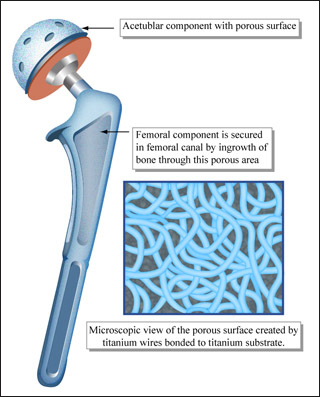
This implant for a total hip replacement is designed with various porous surfaces that encourage tissue ingrowth. (Figure by MIT OpenCourseWare.)
Instructor(s)
Prof. Ioannis Yannas
Prof. Myron Spector
MIT Course Number
20.441J / 2.79J / 3.96J / HST.522J
As Taught In
Fall 2009
Level
Graduate
Course Description
Course Features
Course Description
This course covers the principles of materials science and cell biology underlying the design of medical implants, artificial organs, and matrices for tissue engineering. Methods for biomaterials surface characterization and analysis of protein adsorption on biomaterials. Molecular and cellular interactions with biomaterials are analyzed in terms of unit cell processes, such as matrix synthesis, degradation, and contraction. Mechanisms underlying wound healing and tissue remodeling following implantation in various organs. Tissue and organ regeneration. Design of implants and prostheses based on control of biomaterials-tissue interactions. Comparative analysis of intact, biodegradable, and bioreplaceable implants by reference to case studies. Criteria for restoration of physiological function for tissues and organs.
Other Versions
Other OCW Versions
Archived versions: ![]()


